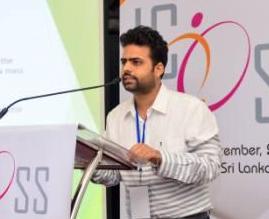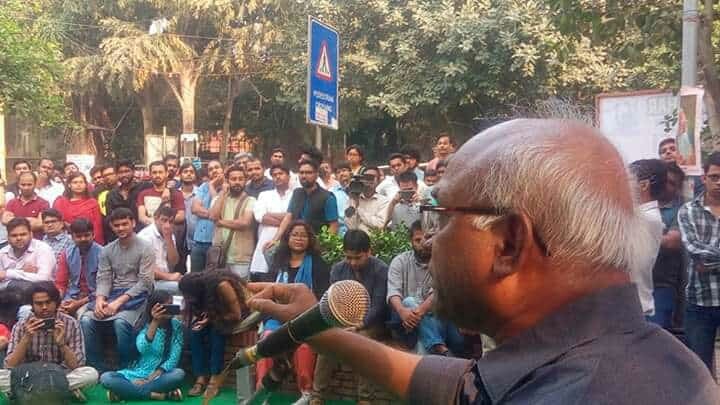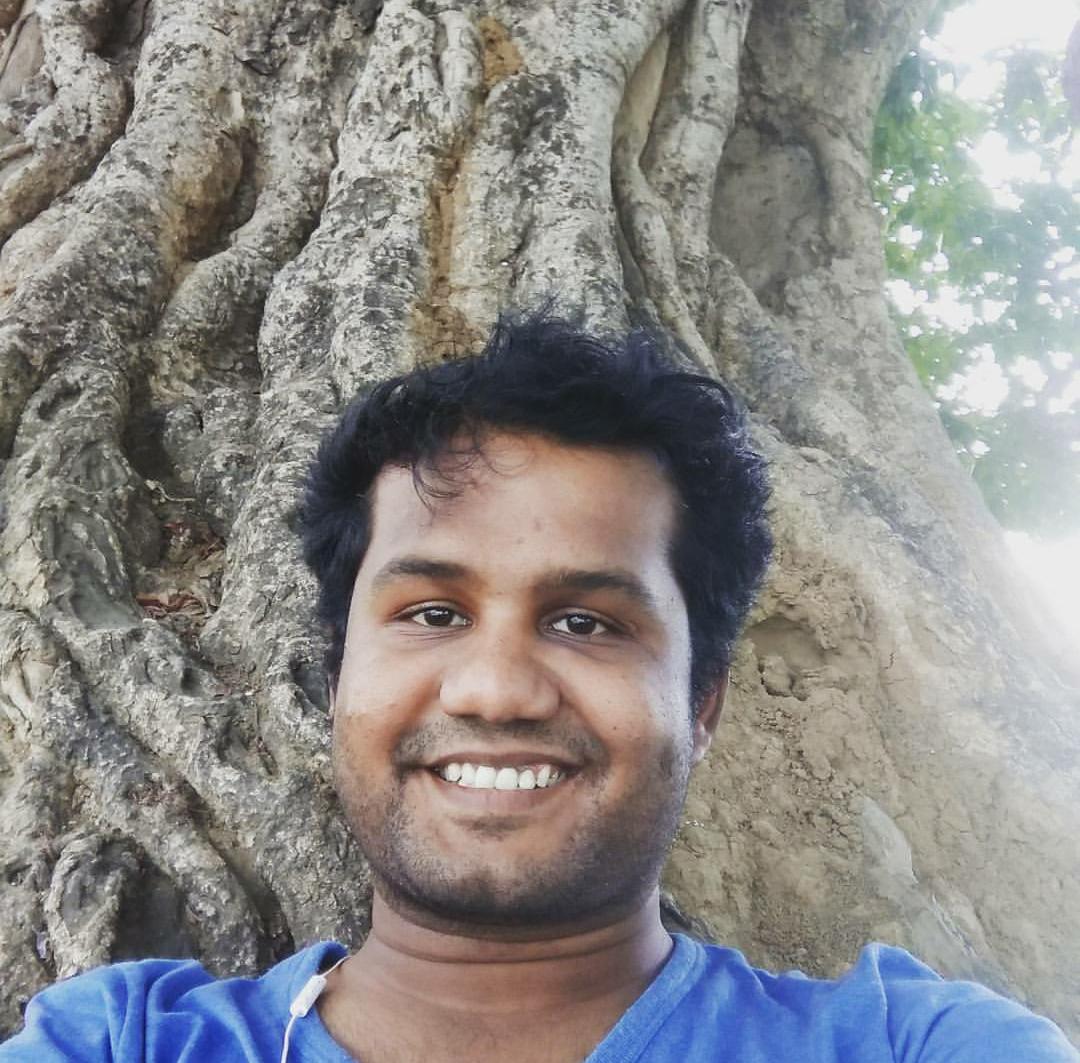Nidhin Shobhana
Recently I had the opportunity to participate and speak in a two-hour session on the ‘Intersectionalities of caste and gender’ conducted by National Campaign on Dalit Human Rights at Miranda House, Delhi. The session aimed at understanding how caste and gender operate in Higher Educational Institutions. It was organized as a part of the on-going Gender Mela by Men Engage.
While preparing for the session, I strongly felt the need to inform myself on the history of higher education in India. As a part of this exercise, I browsed through the history of Miranda House – the venue of our session. I visited the official website. It had brief accounts on the establishment of Miranda House, evolution of its Logo, details of the governing board members, principals, distinguished guests and alumnae over the years. I could also find details on memorial awards instituted by the college, hall of honors, list of alumnae honored for their excellent achievements etc.

From the brief historical sketch, I could gather that Miranda House was established under the patronage of Lord Mountbatten and his wife. In fact, Miranda was his daughter’s name. Established in 1948, the website celebrates this college as a pioneer in women’s education in India. Well, what really interested me were the long lists of alumnae, governing board members, hall of honours, principals, former academic staff, students’ union members and memorial awards. In these long lists, I was looking out for Dalit-Bahujan, Adivasi names. Well, one has to admit that ‘figuring out surnames’ cannot be the best way of discerning caste, especially when Dalit-Bahujans have been extremely creative in subverting caste names and surnames. It should also be noted that Brahmin-Savarnas have hardly displayed such creativity. Very soon it became evident to me that Dalit-Bahujan, Adivasi names are very few or non-existent in those lists.
Instead I should calculate the frequency of certain recurring upper caste surnames. For example, the surname ‘Gupta’ appeared 36 times in the lists. Similarly, Sharma appeared 31 times; Menon appeared 20 times; Kapoor appeared 15 times; Chaterjee 12 times; Bhattacharjee/Bhattacharya -12 times; Banerjee- 10 times; Maheshwari -7 times; Rao -33 times; Deshmukh – 8 times; Sen/ Sengupta/Dasgupta – 15 times ; Tripathi -15 times; Chakravarty – 12 times so on and so forth. Most of the familiar Brahmin-Bania surnames were represented in these important lists.
I did find one list which exclusively named Dalit-Bahujans. It appeared along with the list of staff, part of the early days of the Miranda family. I reproduce the list here –
Karamcharis of 1948 batch Category ‘D’
Asgar (Driver)
Chattai (Chowkidar)
Kacheroo (Safai Karamchari)
John (Chowkidar)
Jeet Ram (Havaldar)
Masih Charan (Chowkidar)
Mohan (Lal Mali)
Peroo (Peon)
Mrs. Phulloo (Safai Karamchari)
Ms. Janaki (Maid)
Most of the names in this list do not have surnames. I wonder whether the enumerators ever spoke to any of them to know their full names, or maybe, they did not have surnames which marked them as powerful individuals or groups, unlike the recurring surnames mentioned above.
Surnames are value loaded. They are historical. They tell us who should be revered and who should be treated with contempt in a caste-based society. For example, the recurring appearance of a historically powerful surname such as Bhattacharya in the ‘hall of honours’ reinstates and reproduces its power in a supposedly modern public institution like Miranda House. It is disseminated through new means of modern communication. For anyone, who is not sensitive to the history of Higher Education may understand the recurring appearance of certain surnames in terms of talent, merit, eugenics, biology etc.
Such ahistorical consumptions of surnames do not emerge in a vacuum. They play-out within a Brahmin-supremacist patriarchal caste order. Such an order controls, privatizes and appropriates cultures, fruits of labour and places. This can be achieved only when all of us (minutely graded in a hierarchy) have a common hegemonic source of reverence. This common hegemonic source of reverence is the ‘Brahmin’ and his ‘notion of absolute supremacy’. Anu Ramdas asks pertinent questions in her essay ‘The Brahmin Problem’ to discern the nature of this supremacy[1]. In other words, Brahmanism is the ‘hegemonic common’ that all of us share and perpetuate for the upkeep of the order. This hegemony manifests in ‘reading’ and ‘listing’ surnames. Hardly anyone would be startled by the recurring appearance of Bhattacharya in the hall of honours, precisely due to its hegemonic influence. It naturalizes and racializes intellectual hierarchies.
To avoid such structural pitfalls let us take a glance at the history of Higher Education in India to precisely understand why certain surnames keep recurring in the ‘meritorious lists’ of Miranda House.
Syed Nurullah and J.P.Naik in their book[2] chronicle the history of Education in India. They specifically dedicate three chapters on the establishment and growth of Indian Universities. They also reflect on the systems of learning which existed prior to British intervention. These reflections are based on the enquiries conducted by British officials or missionaries in early 19th century in Madras, Bombay and Calcutta. Such enquiries categorically prove that education was almost always ‘confined to the Brahmins or the mercantile classes’.
Initially, the British government focused on ‘encouraging the learned natives of India’ by spending a sum of not less than one lakh rupees every year on them[3]. The underlying assumption being that the so called ‘learned’ (read as Brahmins and allied ‘upper castes’) would introduce and promote the knowledge of science among the inhabitants of India. However, this scheme did not operationalize. On the other hand, any attempt by Dalits and Bahujans to enter schools and other spaces of learning was vehemently opposed by the ‘learned natives’.
The example of Swadeshabhimani Ramakrishna Pillai, a Brahmanical nationalist and Malayalam translator of Karl Marx’s biography is quite telling. When Travancore princely state, passed an order for Dalit school entry in early 20th century as a result of persistent anti-caste mobilization by Ayyankali and others; Ramakrishna Pillai wrote an editorial which not only opposed such a move but also humiliated Dalits by stating that ‘Children of those who have cultivated land for centuries cannot be seated along with children of those who have cultivated their brains for centuries’.
Similarly, A.K. Biswas[4] documents how Ishwar Chandra Vidyasagar and Sir Surendra Nath Banerjea clearly stood against democratization of Higher Education in Colonial India. A.K. Biswas quotes the letter written by Vidyasagar on September 29, 1859 to John Peter Grant, the Lieutenant Governor of Bengal, opposing the Charles Woods Dispatch of 1854[5] which proposed ‘mass’ education. Vidyasagar writes –
An impression appears to have gained ground, both here and in England, that enough has been done for the education of the higher classes and that attention should now be directed towards the education of the masses… An enquiry into the matter will, however, show a very different state of things. As the best, if not the only practicable means of promoting education in Bengal, the Government should, in my humble opinion, confine itself to the education of the higher classes on a comprehensive scale.
Vidyasagar, whose heroic individualism is revered by many, categorically advocated for confining education to ‘higher classes’ (both men and women). In the same essay, A.K. Biswas points out that a wealthy man from the goldsmith community was denied admission in Sanskrit College by Vidyasagar due to the ‘low-caste’ status of goldsmiths. Similarly, Sir Surendra Nath Banerjea and Sir Ashutosh Mukherjee vehemently opposed the setting up of Dhaka University in 1911. They delayed the process for over a decade. Biswas points out that Dhaka University would have posed a serious challenge to the hegemony of Calcutta University. Moreover, it would have primarily catered the aspirations of Muslims and Dalit-Bahujan Hindus who dominated East Bengal. One can quote several such examples of Brahmin-Savarna betrayal.
The first colleges were set up with the help the British Government in early 19th century[6]. These colleges were modeled as per the pre-existing systems of learning, specific to Brahmin- Savarna Hindus and Muslims. Later modern colleges were established under the banner of missionaries in Bombay, Madras, Agra, Delhi and Calcutta. These colleges also catered chiefly to the Brahmin-Savarnas of the country. Commenting on this period, Dr. Babasaheb Ambedkar, in his essay ‘Christianizing India’ points out that the Missionaries initially aimed at converting Brahmins and other ‘upper castes’. They tried to achieve this aim by setting up Colleges, Schools and Hospitals. The major benefits of Christian institutions were reaped by the ‘high caste Hindus’. Neither the composition nor the curriculum of these institutions reflected the social conflicts or diversity of India.
Late 19th century and early 20th century witnessed the rise of Brahmanical nationalists who established colleges across the country[7] with the help of the grant-in-aid provided by the Colonial Government. The network of colleges and universities, prepared the Brahmanical elite to readily possess government jobs. The rise of Indian National Congress during the same period consolidated the position of these groups further. For example, S.R. Talukder in his essay titled ‘Indian Civil Service Examination and The Savarna Merit’[8] tells us how ‘upper’ caste Indians consistently underperformed in Indian Civil Services despite of having non-discriminatory schooling in missionary schools and colleges, consolidation of land ownership through Permanent Settlement of Zamindari System, political power through Indian National Congress and cultural supremacy in every walk of life. In order to redress this ‘non-meritocracy’, they made use of Indian National Congress as a pressure group. British administration provided several measures , such as ‘reservations’, ‘relaxed age limits’, ‘priority in specific appointments’, ‘examination in Indian centers’ and ‘political nominations’ for the Brahmanical elite. Ultimately, the numbers tilted in the favor of upper-caste Indians only after Europeans persistently backtracked from ICS after World War –I. Bhagwan Das[9] notes that the Brahmins in Madras and the Bhadralok in Calcutta colonized the advantages of the new educational policies and captured most of the posts available in the administration.
Talukder, in the same book, points out that 15th August 1947 was a ‘day of miracle’ for the Brahmin-Savarnas. It laid bare all the important positions in public institutions for upper-castes. Newly independent India was an open field of public institutions which required to be ‘manned’. While Satish Deshpande call this the ‘historical luck of upper castes’, I think we need to rephrase it as the ‘historical conspiracy of the uppercastes’.
Well, Miranda House was established on 7th March 1948, as a college exclusively for women under Delhi University. From the preceding brief account on Indian Higher Education it is evident that Brahmin-Savarna men and later women systematically manufactured their dominance by denying equal share to others. They captured all important decision-making bodies in the early decades of Post-Colonial India. Miranda House is no exception. The ‘meritorious lists’ which decorate its website are nothing but an index of this history of betrayal and supremacy. We need to decry the sectional and provincial nature of these ‘meritorious’ lists and institutions. They do not represent the ‘nation’. The principle of representation was historically sidelined, ensuring the reproduction of Brahmin-supremacist patriarchal caste order.
Now, I think, we are adequately equipped to understand the recurring mention of certain surnames in those lists. Thus we can reformulate Miranda House as a pioneering institution in ‘Brahmin-Savarna’ women’s education in India. It has achieved an amazing unity of Brahmanical elites across religion, the lists evidence this fact. Meritorious lists are modern day sanitized reproductions of Brahmanic hegemony. They index the undemocratic nature of our educational institutions.
The next time we check out the website of Miranda House let us not attribute the repeated mention of Bhattacharya in powerful lists with the size of their skulls or genetic composition. Let us attribute it to the history of Higher Education which has been both been exclusive and Brahmin-supremacist. The statistics of All India Survey on Higher Education Provincial Report 2014-15, is a grim reminder of the nature of Higher Education in India. With more than 65% Brahmin-Savarna teachers (or more than 300% over-representation of Brahmin-Savarna Men and Women teachers), Indian Higher Education continues to stay committed to its embarrassing history. Without dismantling these ‘meritorious lists’ and skewed compositions there is no point in ‘protecting’ pioneering institutions and colleges.
[1] Anu Ramdas, ‘The Brahmin Problem’, Round Table India
[2]Nurullah, S., & Naik, J. P. (1951).A history of education in India during the British period. Macmillan.
[3] Charter Act of 1813
[4] A.K. Biswas ‘ Universalisation of Education: India in a trap’ http://mainstreamweekly.net/article1615.html
[5] The Charles Woods Dispatch recognized the failure of focusing only on the education of the ‘higher classes’ (read as upper-castes) and discredited the ‘Downwards Filtration Theory’. See A.K. Biswas http://www.mainstreamweekly.net/article1615.html
[6] These include Calcutta Madrassa and Benaras Sanskrit College.
[7] Fergusson College, Pune; Anglo Oriental College, Aligarh; Pachaiyappa College and the Hindu Colleges at Vizagapatanam and Tinnevelly, Madras etc.
[8] S.R.Talukder (1998), ‘Indian Civil Service Examination and Savarna Merit’, Blumoon Books : New Delhi
[9] Das Bhagwan (2000), Moments in the History of Reservations, EPW, October 28, 2000 (retrieved from www.ambedkar.org)
~~~
Illustration by Nidhin Shobhana.
Nidhin Shobhana is an artist and writer and is the Associate Program Coordinator at National Campaign on Dalit Humann Rights (NCDHR).










